Wheel Size: 29’’
Travel:
- Frame: 125 mm
- Fork: 140 mm
Geometry Highlights:
- Sizes Offered: Small, Medium, Large, XL
- Headtube Angle: 64.4° (low setting)
- Seat Tube Angle: 77.9° (effective, low setting)
- Reach: 498 mm (size Large)
- Chainstay Length: 433 mm
Frame Material: Carbon Fiber
Price: Complete Bikes $3,999 to $6,499
Wheel Size: 29’’
Travel:
- Frame: 145 mm
- Fork: 160 mm
Geometry Highlights:
- Sizes Offered: Small, Medium, Large, XL
- Headtube Angle: 63.6° (low setting)
- Seat Tube Angle: 77.1° (effective, low setting)
- Reach: 489 mm (size Large)
- Chainstay Length: 433 mm
Frame Material: Carbon Fiber
Price:
- Frame w/ Fox Float X Factory shock: $3,199
- Complete Bikes: $3,999 to $8,999
Blister’s Measured Weight (Blackthorn 145 C GX Transmission, size L, w/o pedals): 33.80 lbs / 15.33 kg
Test Location: Washington, Colorado, & New Mexico
Reviewers:
- Simon Stewart: 6’, 170 lb / 183 cm, 74.8 kg
- David Golay: 6’, 160 lb / 183 cm, 72.6 kg
Test Duration: 4 months
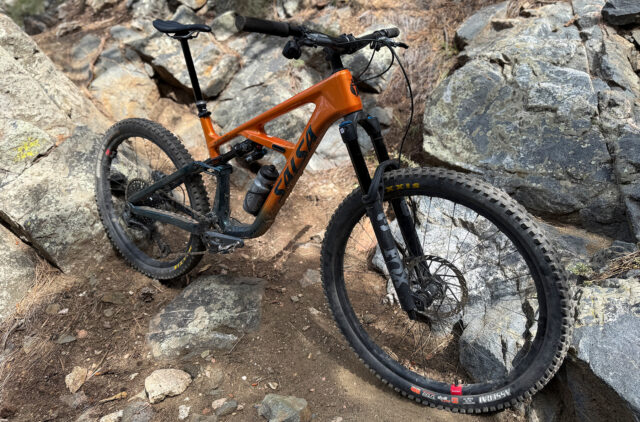
Intro
Salsa has become better known for their gravel and bikepacking bikes in recent years, but they’ve continued to have a few mountain bikes in their lineup as well. They’ve recently given their MTB lineup a big overhaul, with a new version of the Spearfish XC bike (more on that one coming soon), a carbon fiber version of their Notch eMTB, and a pair of new Trail / All Mountain bikes, the Blackthorn 125 C and Blackthorn 145 C, which we’re covering here.
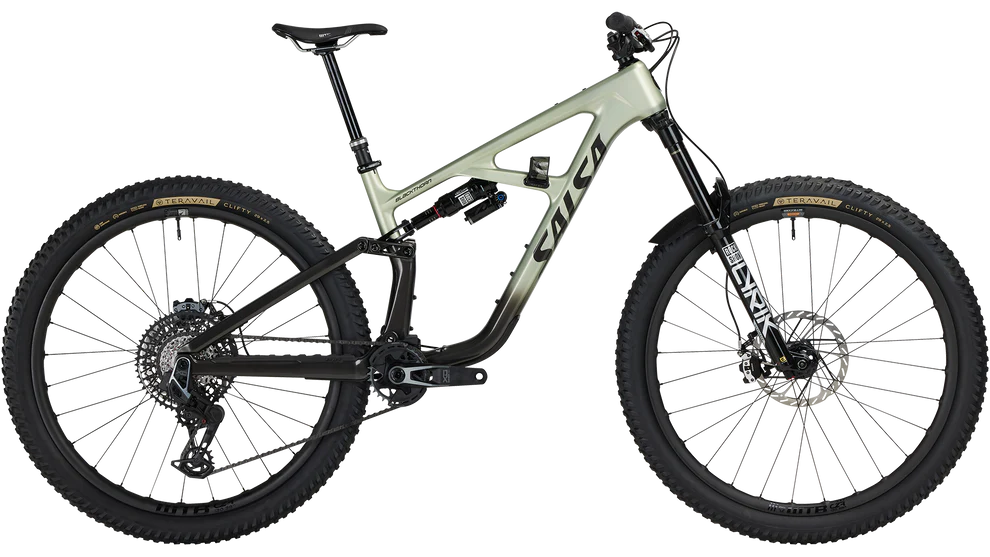
The Frame
The Blackthorn 125 C and Blackthorn 145 C share the same main frame, with their travel and geometry differences handled by swapping the shock yoke and shock, with a corresponding fork travel change to match. They’re offered in carbon fiber only and use a Split Pivot suspension layout. The Blackthorn 125 C gets its 125 mm of rear wheel travel from a 190 x 45 mm shock, while the Blackthorn 145 C adds 20 mm of travel by way of a 210 x 55 mm shock, with a shorter shock yoke to compensate for the longer shock. Salsa doesn’t publish suspension kinematics for either version.
Both versions of the shock yoke feature a geometry-adjusting flip chip at the rear shock mount. The Blackthorn 125 is designed around a 140 mm travel fork, while the Blackthorn 145 gets a 160 mm travel one. Both are designed around 29’’ wheels at both ends, but can be run with a 27.5’’ rear wheel with the flip chip in the high setting; Salsa recommends running 165 mm cranks or shorter in the mullet configuration, with a 2.5’’ rear tire and a 2.4’’ front one to steepen the bike a touch.
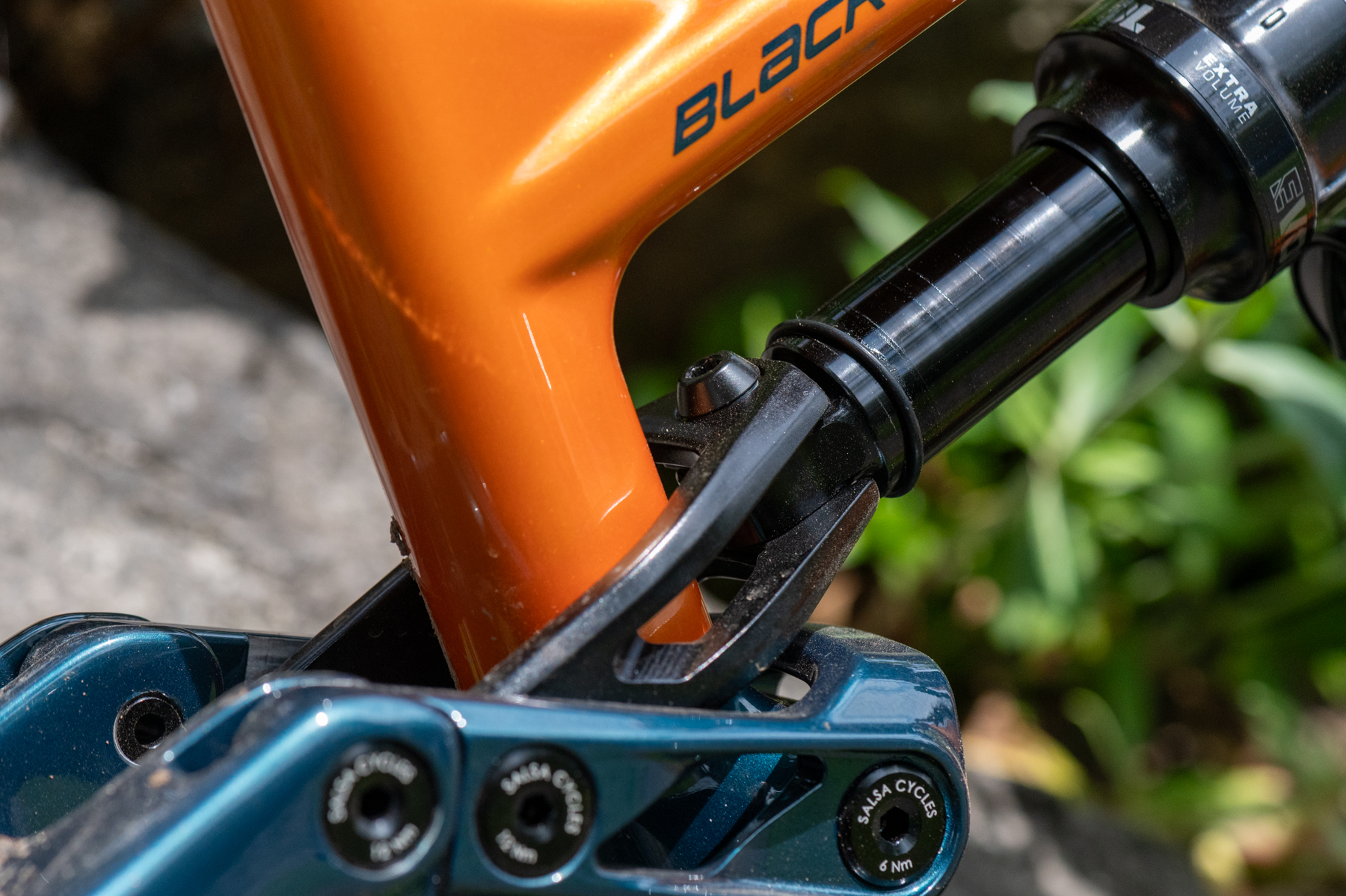
Salsa makes a wide range of gravel / bikepacking bikes, and some of that ethos has carried over to the Blackthorn when it comes to on-bike storage. You can fit two water bottles inside the front triangle on all frame sizes (one on the downtube, one on the lower portion of the seat tube), and the downtube mounts feature a third bolt to allow two different mounting positions and/or more space for accessories. And then there’s a third set of mounts on top of the top tube for a small frame bag or other accessories, and an integrated tube strap on top of the brace between the downtube and top tube.
The other frame details are fairly standard — reasonably so, in my book. The bottom bracket is threaded, with removable ISCG tabs; the cable routing is internal and fully guided (though, somewhat unusually, all three ports are on the left side of the headtube); and the Blackthorn frames use standard 148 mm Boost rear hub spacing with a SRAM UDH for Transmission compatibility and ease of sourcing replacement hangers. Rubber guards protect the drive side chain and seat stays, the underside of the down tube, and the main pivot area.
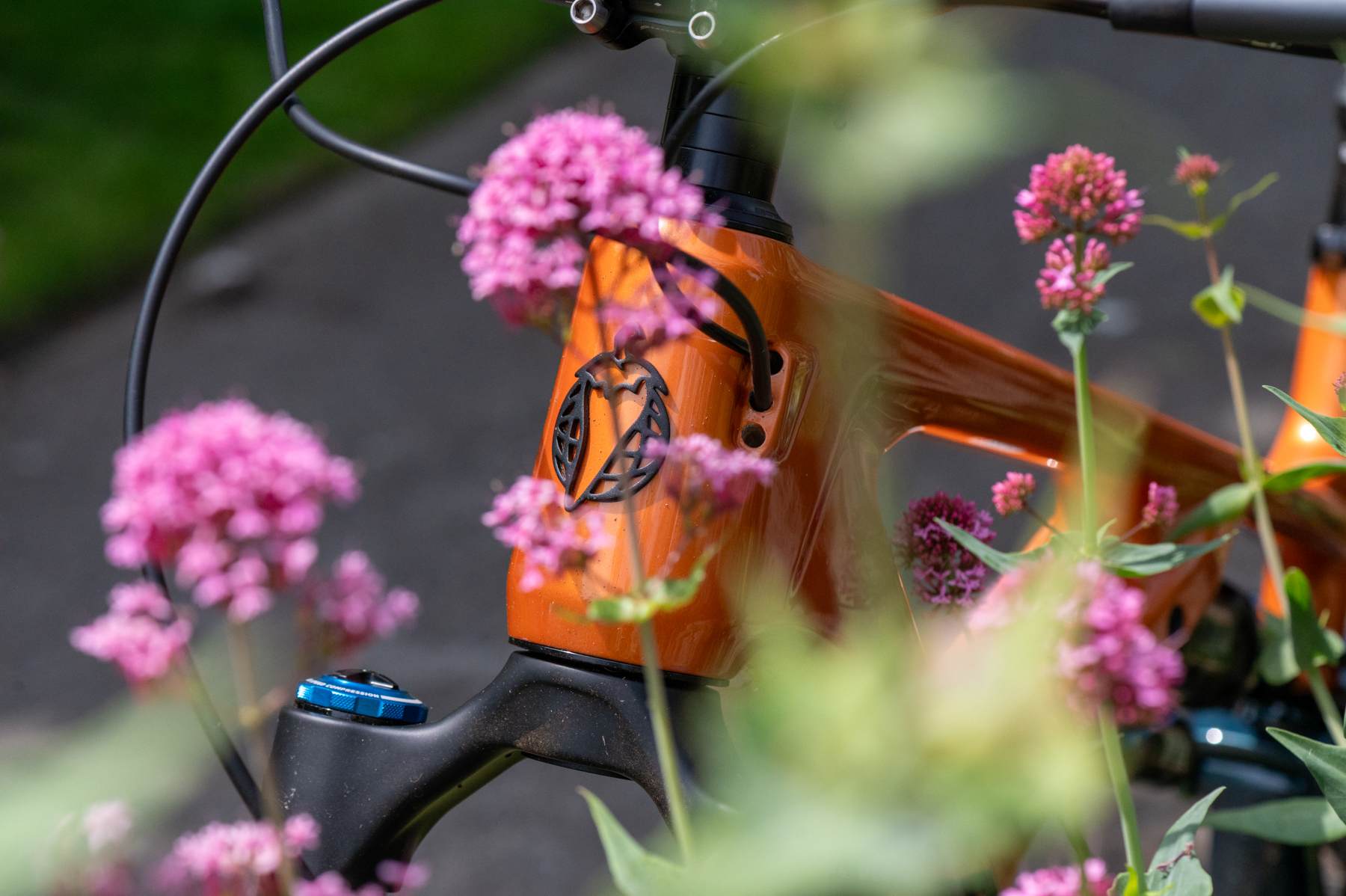
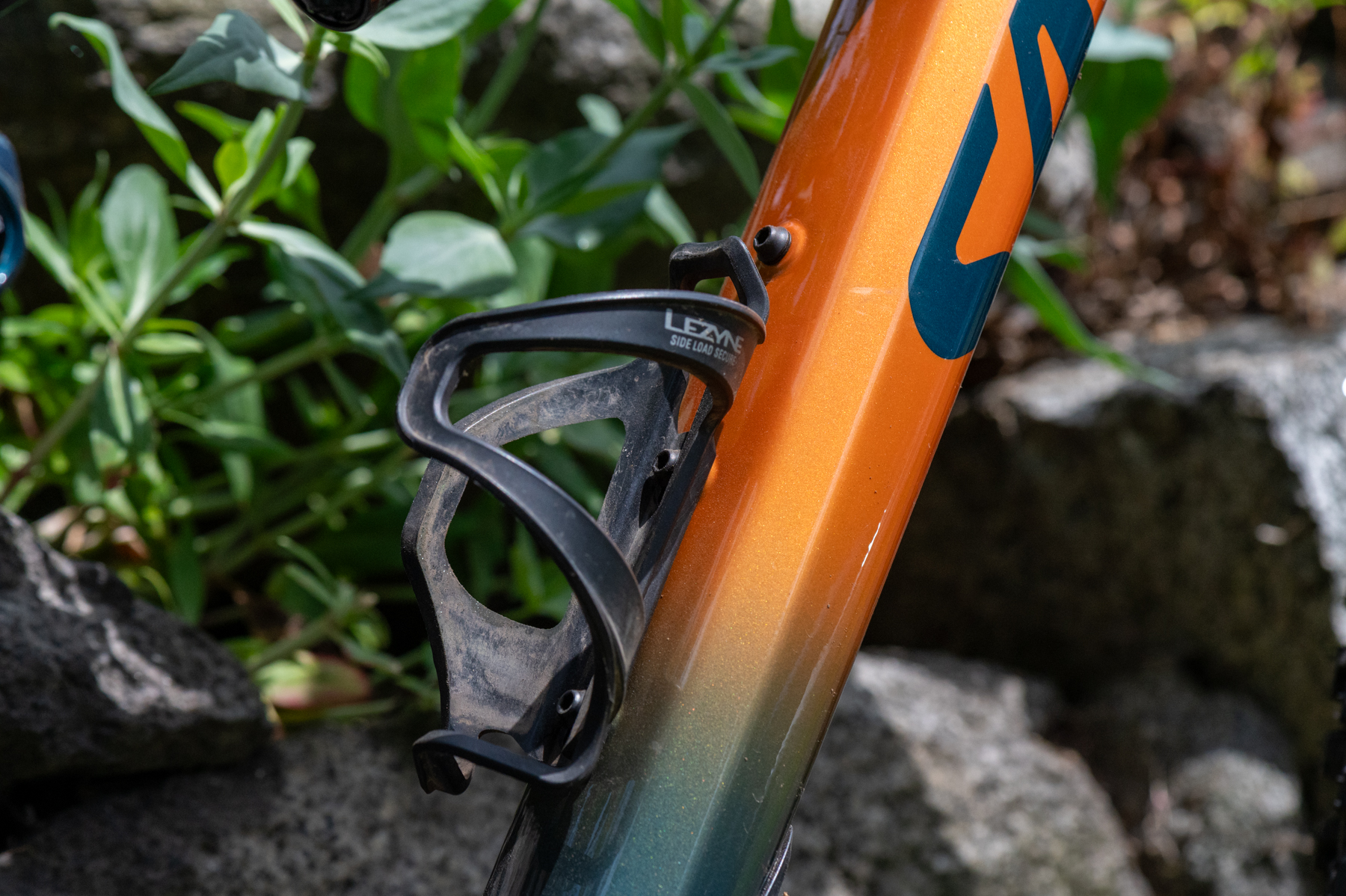
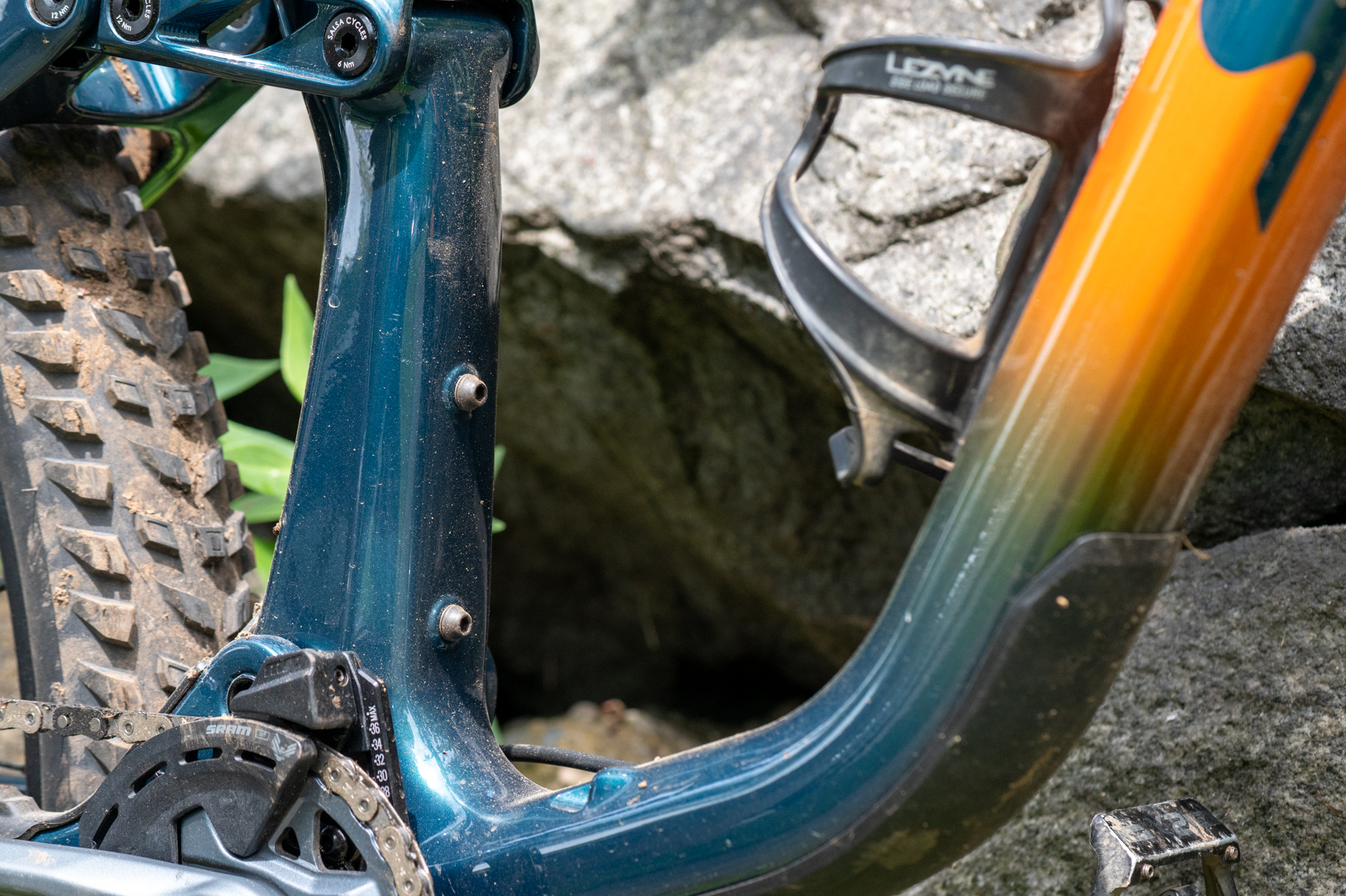
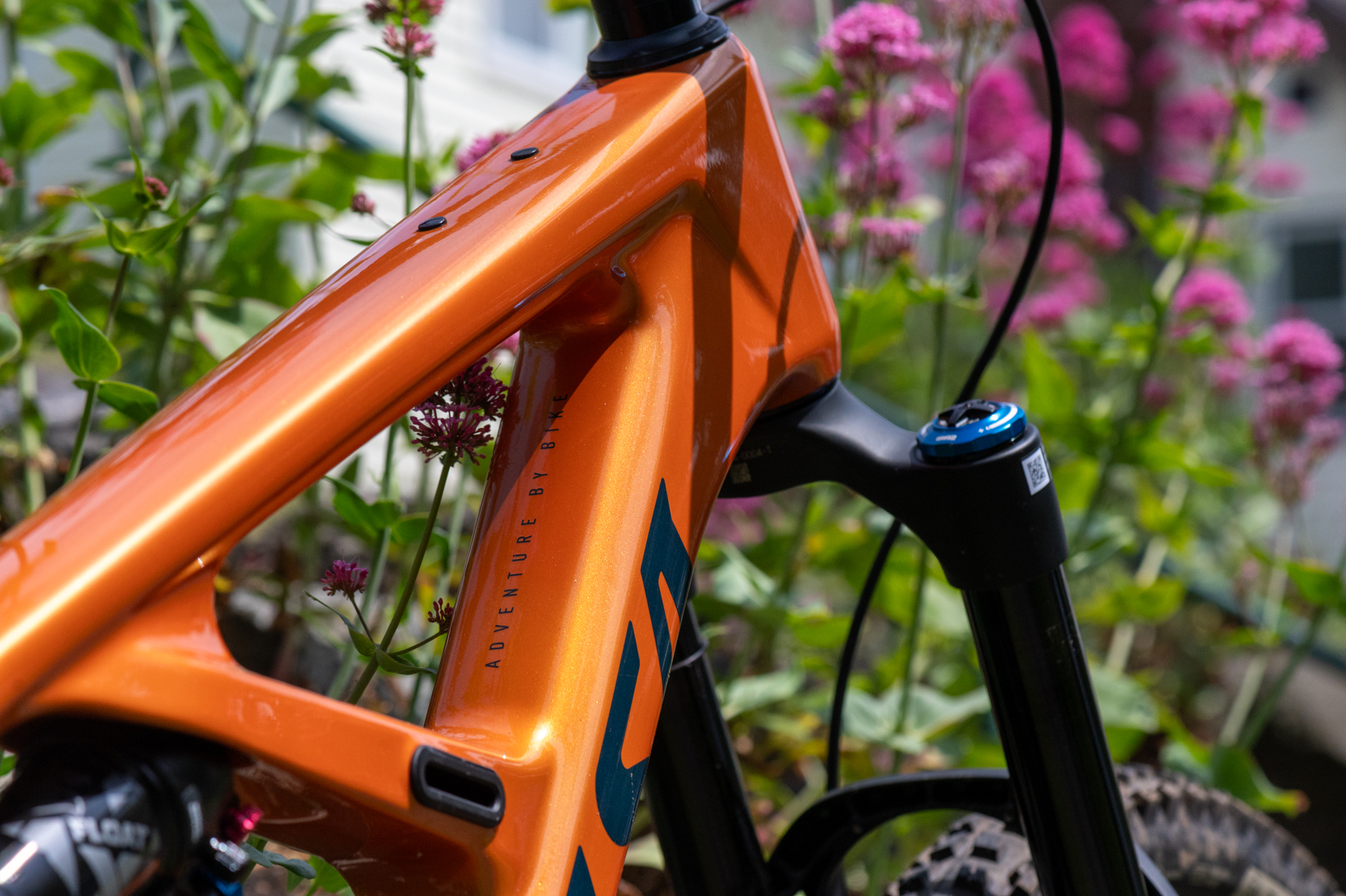
Fit & Geometry
The Blackthorn siblings are offered in four sizes, Small through XL, with 20 mm steps in reach between them. Both feature relatively short 433 mm chainstays across the size range, and their geometry is largely similar overall (again, they share the same frame apart from the shock and yoke), with the Blackthorn 125 being a bit lower and steeper due to its shorter fork.
Geometry: Blackthorn 125 C
In the 125 configuration, the Blackthorn gets 64.7° headtube and 78.3° seat tube angles and a 32 mm bottom bracket drop, in the default geometry setting; switching to the low position adds 4 mm to the bottom bracket drop and slackens the angles to 64.4° and 77.9°, respe ctively.
Reach starts at 462 mm on the Small frame and grows by ~20 mm per size from there (again in the default geometry setting; the low one shortens the reach by a few millimeters). That’s somewhat on the long side, but the steep seat tube reins in the effective top tube measurements to relatively standard figures.
Geometry: Blackthorn 145 C
The Blackthorn 145 C is a little higher and slacker than the 125 C, but its geometry isn’t massively different overall. The headtube angle sits at 63.9° / 63.6° (depending on the flip chip setting), with the seat tube angle slackened a touch to a (still pretty steep) 77.5° / 77.1°. The bottom bracket drop is now 25 mm (default) or 30 mm (low), which should produce a similar height at sag to the Blackthorn 125 C. The Blackthorn 145 C also gets slightly shorter reach and higher stack figures, due to the slacker headtube angle and the fact that the two share a frame. Reach starts at 453 mm on the Small and grows by about 20 mm per size, up to 512 mm on the XL.
The Builds
Blackthorn 125 C
Salsa offers two builds on the Blackthorn 125 C. The entry-level Deore build gets (surprise) a Shimano Deore 12-speed drivetrain and four-piston brakes, with the base versions of RockShox’s Pike fork and Super Deluxe shock handling suspension duties. The higher-spec GX Transmission build gets a SRAM GX Transmission groupset with Code Bronze Stealth brakes, and Performance Elite tier Fox 36 SL / Float X suspension.
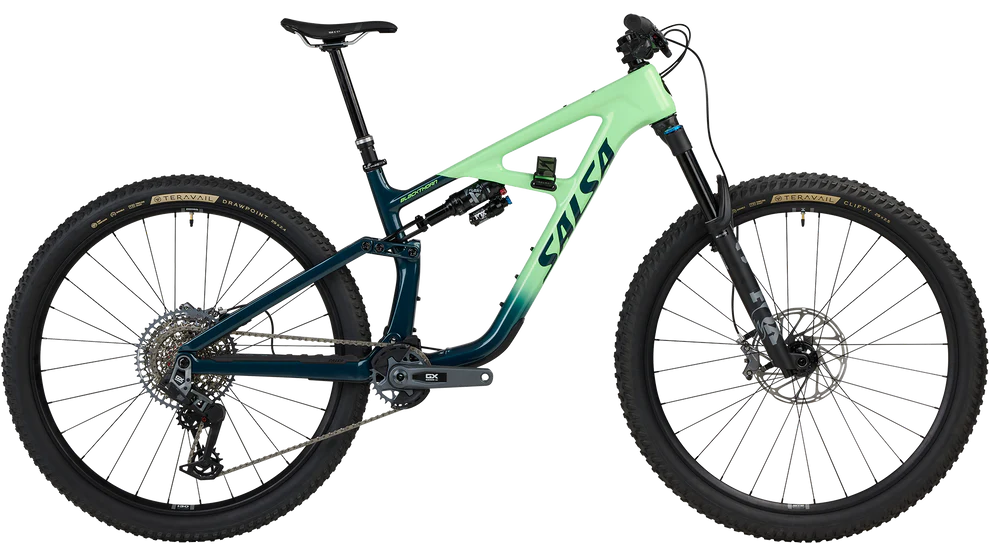
- Drivetrain: Shimano Deore 12-speed
- Brakes: Shimano Deore 4-piston w/ 203 mm front / 180 mm rear rotors
- Fork: RockShox Pike
- Shock: RockShox Super Deluxe
- Wheels: Shimano TC500 hubs w/ WTB i30 TCS rims
- Dropper Post: TransX YS105 (S: 150 mm / M & L: 175 mm / XL: 200 mm)
- Drivetrain: SRAM GX Transmission
- Brakes: SRAM Code Bronze Stealth w/ 200 mm front / 180 mm rear rotors
- Fork: Fox 36 SL Performance Elite
- Shock: Fox Float X Performance Elite
- Wheels: WTB Frequency hubs w/ WTB i30 TCS rims
- Dropper Post: TransX Reverse (S: 160 mm / M: 180 mm / L & XL: 210 mm)
Blackthorn 145 C
The Blackthorn 145 C is offered in three build kits, with the Deore and GX Transmission ones closely mirroring the corresponding builds on the Blackthorn 125 C, plus a higher-end X0 Transmission build above them. The Deore build on the Blackthorn 145 C gets a RockShox Lyrik Base fork and a 203 mm rear brake rotor, but is otherwise the same as the Blackthorn 125 C Deore; the Blackthorn 145 C GX Transmission bumps up to a Fox 36 Performance Elite fork with the Grip X2 damper and SRAM Maven Bronze brakes, with the rest of the spec matching that of the Blackthorn 125 C GX Transmission.
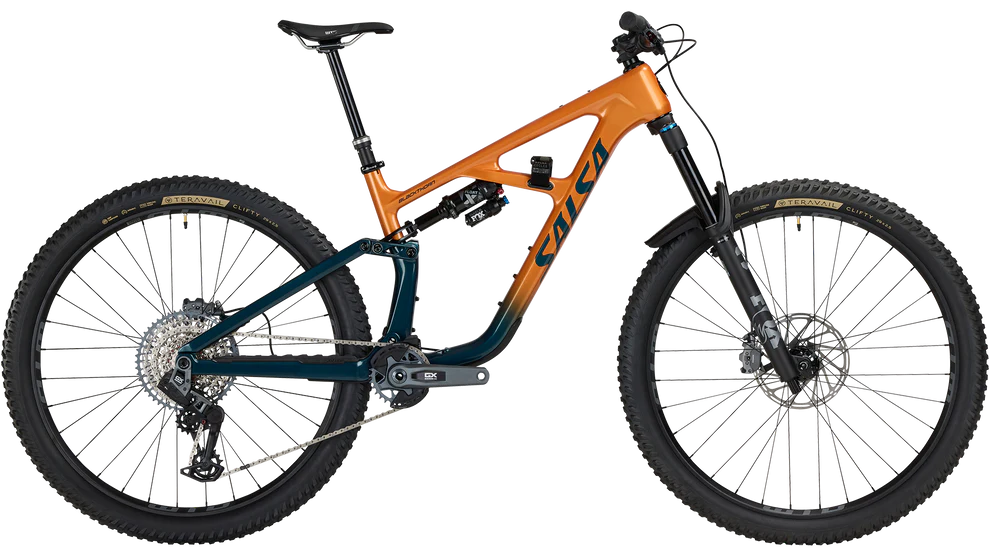
- Drivetrain: Shimano Deore 12-speed
- Brakes: Shimano Deore 4-piston w/ 203 mm rotors
- Fork: RockShox Lyrik
- Shock: RockShox Super Deluxe
- Wheels: Shimano TC500 hubs w/ WTB i30 TCS rims
- Dropper Post: TransX YS105 (S: 150 mm / M & L: 175 mm / XL: 200 mm)
- Drivetrain: SRAM GX Transmission
- Brakes: SRAM Maven Bronze Stealth w/ 200 mm Centerline rotors
- Fork: Fox 36 Performance Elite Grip X2
- Shock: Fox Float X Performance Elite
- Wheels: WTB Frequency hubs w/ WTB i30 TCS rims
- Dropper Post: TransX Reverse (S: 160 mm / M: 180 mm / L & XL: 210 mm)
- Drivetrain: SRAM X0 Transmission
- Brakes: SRAM Maven Ultimate Stealth w/ 200 mm HS2 rotors
- Fork: RockShox Lyrik Ultimate
- Shock: RockShox Super Deluxe Ultimate
- Wheels: WTB Frequency hubs w/ WTB CZR Carbon rims
- Dropper Post: TransX Reverse (S: 160 mm / M: 180 mm / L & XL: 210 mm)
Some Questions / Things We’re Curious About
(1) How will the Blackthorn’s progressive geometry relate to the fit and on-trail performance?
(2) How will the Blackthorn 145 perform in the mullet configuration, and will the recommended switch to 165 mm cranks be necessary?
(3) And how does the Blackthorn 145 stack up in a crowded market of do-it-all Trail bikes?
Bottom Line (For Now)
The new Salsa Blackthorn siblings look like interesting takes on all-rounder Trail / All Mountain bikes, and we’ve started spending time on the Blackthorn 145 C to see how it stacks up. BLISTER+ Members and folks with our Digital Access Pass can check out our early impressions, and stay tuned for a Full Review to come.
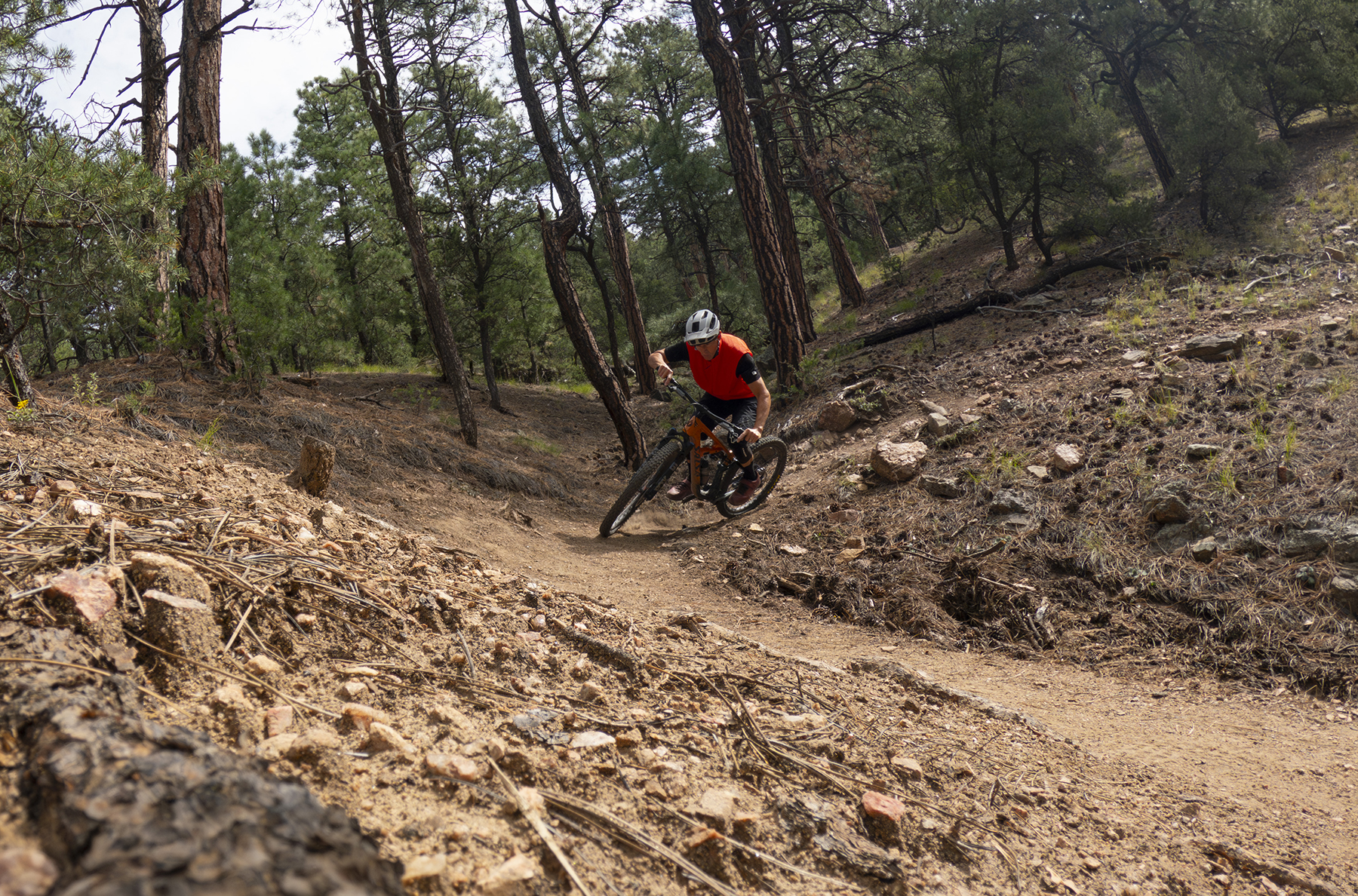
Full Review
Salsa claims the Blackthorn 145 C is the “best All-Mountain bike for chasing adventure by bike in the mountains”. That’s a fairly bold claim coming from a bike company based in Minnesota. But, Salsa does have a proven history of tapping into the adventure side of mountain biking, and the Blackthorn does come equipped with plenty of on-bike storage mounts to carry adventure gear. But we were much more interested in how it performed as an All-Mountain bike, so, having no shortage of mountains at our disposal, put it to the test in the steep terrain of the PNW, the thin air of the Colorado high country, and the rugged mountains of New Mexico. We came away mostly impressed by the Blackthorn’s intriguing combination of traits, so let’s dig in.
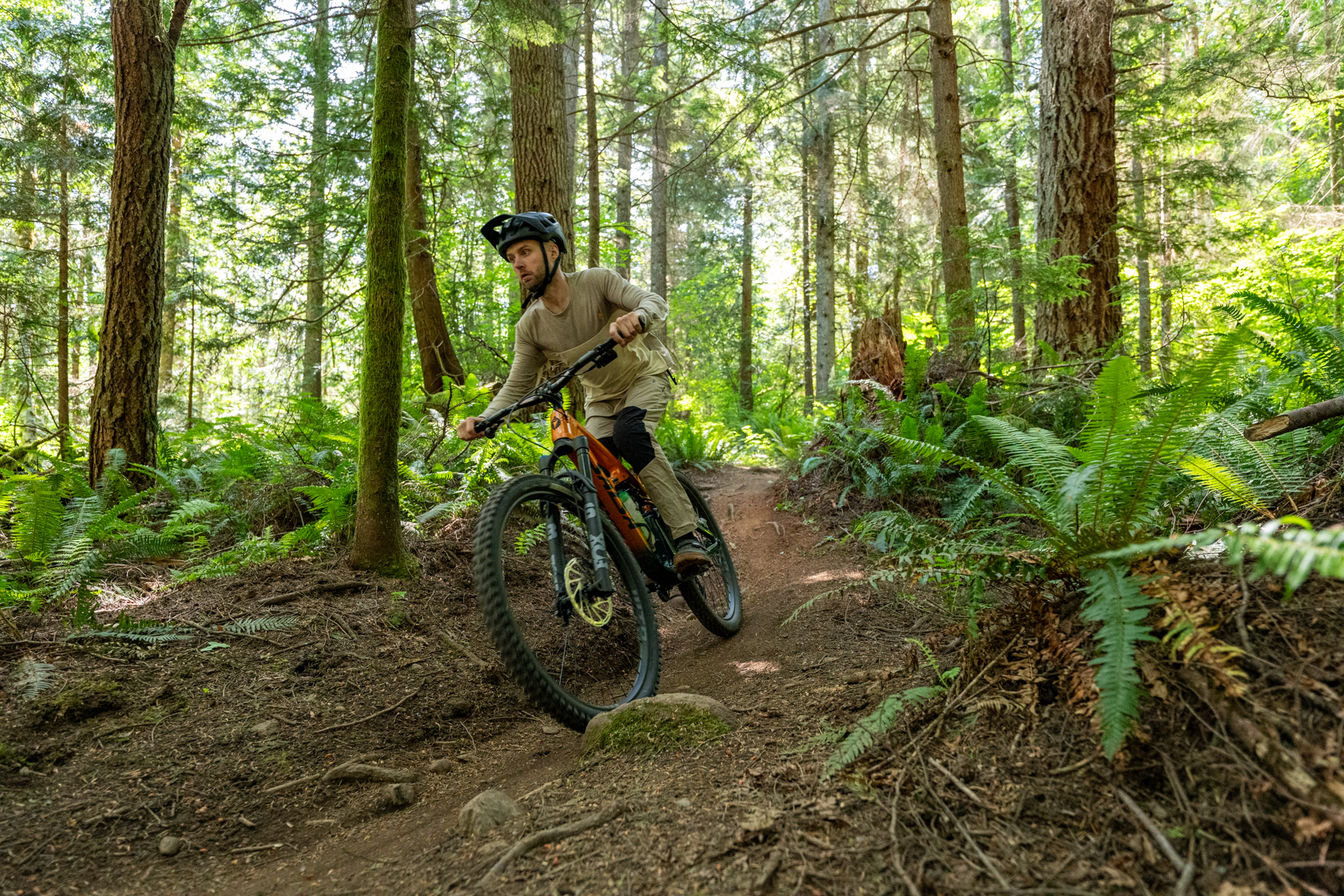
Fit & Sizing
Simon Stewart (6’, 170 lb / 183 cm, 74.8 kg): We touched on the fit being on the more compact side than the geometry numbers suggest for our size Large Blackthorn 145 in the Flash Review, and David and I both had an easy time getting comfortable on it. I found the long-ish 489 mm reach (with the flip chip in the Low position) doesn’t translate to a seated riding position that feels too stretched out, and actually, thanks to the notably steep effective seat tube angle (77.1º), it feels quite a bit shorter. Salsa doesn’t provide a recommended sizing chart, so I think the main takeaway is that despite the reach being on the long side (492 – 489 mm), the Blackthorn 145 very much fits how we expect a typical size Large to fit, and riders tempted to size down based on the reach might want to reconsider. I think the same can be said for the rest of the sizes as well, though, if the opportunity exists, getting on one before buying is never a bad idea.
I also mentioned that I would likely swap in some higher-rise bars since I have 30 mm of spacers under the stem, thanks to the low-ish 633 mm stack height (Low position). I typically switch to higher-rise bars in situations like this when I’m concerned about the fit getting a little cramped, since the reach will shrink a bit from the added spacers. However, for me, the Blackthorn 145 has some room to spare in the cockpit, so I didn’t swap in different bars. I have to admit, though, I prefer the aesthetics of fewer spacers and higher-rise bars, so if I owned the Blackthorn 145, it would get a handlebar swap.
With the handlebars at my preferred height, I found the fit to be in between compact and roomy, while still offering enough space to move around. Like I mentioned above, the seated riding position feels just right for me, and especially so on long climbs, where it remained comfortable and allowed me to concentrate on taking advantage of the Blackthorn’s impressive efficiency.
When descending, the Blackthorn 145’s geometry naturally put me in a slightly forward weight bias, which was helpful in keeping the front wheel glued down. However, that also makes quick front wheel lifts and manuals a bit trickier, since it requires a very pronounced rearward weight shift.
David Golay (6’, 160 lb / 183 cm, 72.6 kg): Simon and I are on the same page here. I’ll just underline that the Blackthorn 145 truly doesn’t fit as big as its lengthy reach figures might suggest — as we say a lot around here, reach on its own really isn’t a sufficient metric to size a bike. The Blackthorn 145’s steep seat tube keeps the effective top tube / seated pedaling position in check, and the forward body position that the Blackthorn 145 encourages on the way back down (more on that in a minute) helps make the bike feel a bit more compact than you might expect, too.
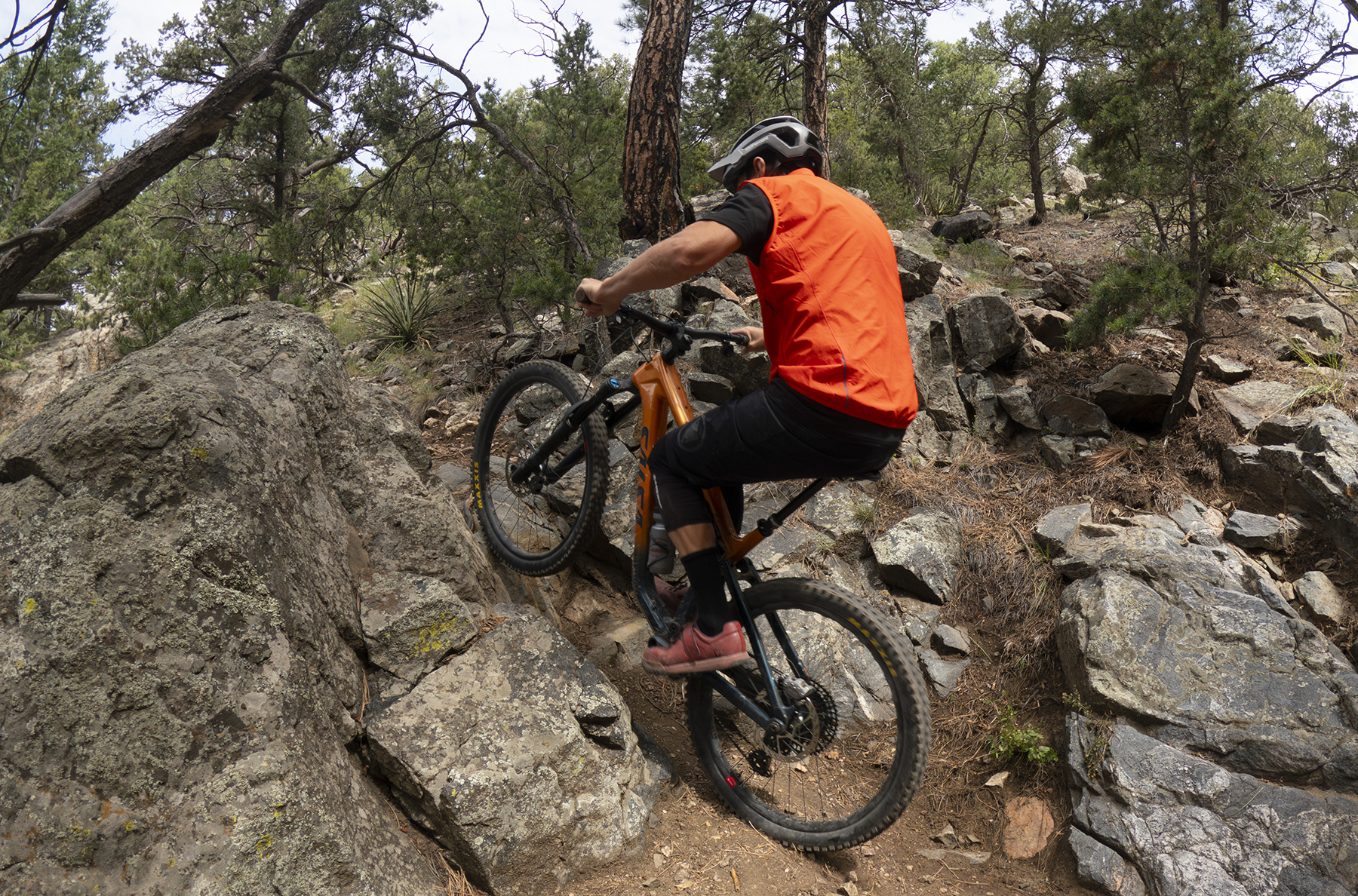
Climbing
Simon: I’ve been thinking about the best way to describe the Blackthorn 145’s climbing performance since I find it to be a good bit outside of what we generally expect from bikes in the ~140 mm travel range. Here’s what I’ve come up with: the Blackthorn 145 flies uphill like an XC race bike that’s put on a few extra pounds in the off-season. To put it into perspective, I went out with a friend who has similar fitness on a Specialized Epic Evo, a highly regarded climber, and the Blackthorn didn’t give up an inch. Being similar in size and fit with the same pedals, we switched bikes midway through a climb, and at the top, he said, “What the hell, I’m pissed, it feels faster than my Epic”. Now, admittedly, there are a lot of other factors at work here, but his seat-of-the-pants impression is hard to dismiss.
The Blackthorn 145 features a fairly upright seated climbing position (slightly compromised by my preference for a higher handlebar height), which translates to a comfortable spot to lock into a rhythm and click off elevation. That upright position, aided by the 77.1º effective seat tube angle, also does a nice job keeping the front end weighted on steep climbs. Given the short 433 mm chainstays, I was expecting the front end to be a handful on steep sections, but that isn’t the case. Additionally, the Blackthorn’s pedaling efficiency helps maintain speed, which is also beneficial when trying to hold a line in steep terrain.
David: I like that line about the Blackthorn 145 climbing like a modern XC bike that’s been hitting the beer and burgers a little too hard — at least from an efficiency standpoint. It’s truly one of the sharpest-pedaling bikes in this travel range that I’ve been on, and while that (unsurprisingly) doesn’t get it all the way to true XC bike territory, the Blackthorn 145 has very few peers that even come close to feeling as snappy as it does on the pedals. (Check out our Deep Dive for more on that.)
As Simon alluded to, though, the Blackthorn 145 feels very different from most XC bikes in its pedaling position, though. The Blackthorn 145 feels much more upright than that class of bikes tends to; whether or not that’s a good thing is probably mostly going to come down to personal preference and what you’re used to.
As someone who spends a lot of time on big Enduro bikes, which tend to feature steeper seat tubes more akin to that of the Blackthorn 145 than most XC rigs, I’m a fan — the Blackthorn 145’s seated pedaling position feels comfortable and familiar. If you’re coming to the Blackthorn 145 from a more XC-focused background, and like the sound of a longer-travel bike that still pedals extremely well, there might be a little more of an adjustment period. But I also think that the Blackthorn 145’s relatively steep seat tube has some advantages, given other aspects of its geometry. Back to Simon for that:
Simon: The Blackthorn 145’s chainstays tuck the back end in tightly beneath the rider, which provides acceptable traction with the stock, somewhat tread-limited, Terevail Clifty rear tire. Switching to a burlier tire, like the Maxxis DHR II (3C MaxxTerra, DoubleDown casing) that I installed with the mullet setup, had an appreciable effect on improving climbing traction, to the point where I would call it above average for the category. I realize it’s not exactly a news flash that a more aggressive tire resulted in better traction, but it’s worth noting that neither the Blackthorn’s geometry nor suspension is holding it back — more on tires in the Build section.
David: To put more of a fine point on that, the short chainstays featured on the Blackthorn 145 definitely help with climbing traction by putting more of the rider’s weight on the rear tire; it also takes more care than some bikes with longer stays to keep the front wheel from wandering when the climbs get really steep. The steep seat tube on the Blackthorn 145 helps moderate that tendency, but I still found myself sliding forward on the nose of the saddle more than I do on a lot of other bikes on especially steep bits.
I’m also probably a little less high on the Blackthorn 145’s traction under power than Simon is. To be clear, I don’t think it’s particularly lacking, either, but between the not-super-grippy (but quite fast-rolling) tire spec and firm, efficient suspension, the Blackthorn 145 isn’t a bike that lets you put down power with reckless abandon when traction is limited.
Simon: Thanks again to the short chainstays, which help make the front end of the Blackthorn 145 easy to pick up and place the front wheel on ledges, and supportive suspension that manages big weight shifts effectively, the Blackthorn 145 offers predictable technical climbing performance. The tradeoff is that there are times when I would prefer a bit more compliance from the rear end — such as when getting over bigger trail features and trying to compress the rear suspension leading into tall ledges and using the rebound to help boost the back end up and over, I often wouldn’t get as far into the travel as I wanted.
I got along best with the Blackthorn 145 on long, high alpine backcountry rides where its efficiency and comfortable seated riding position were the stars of the show.
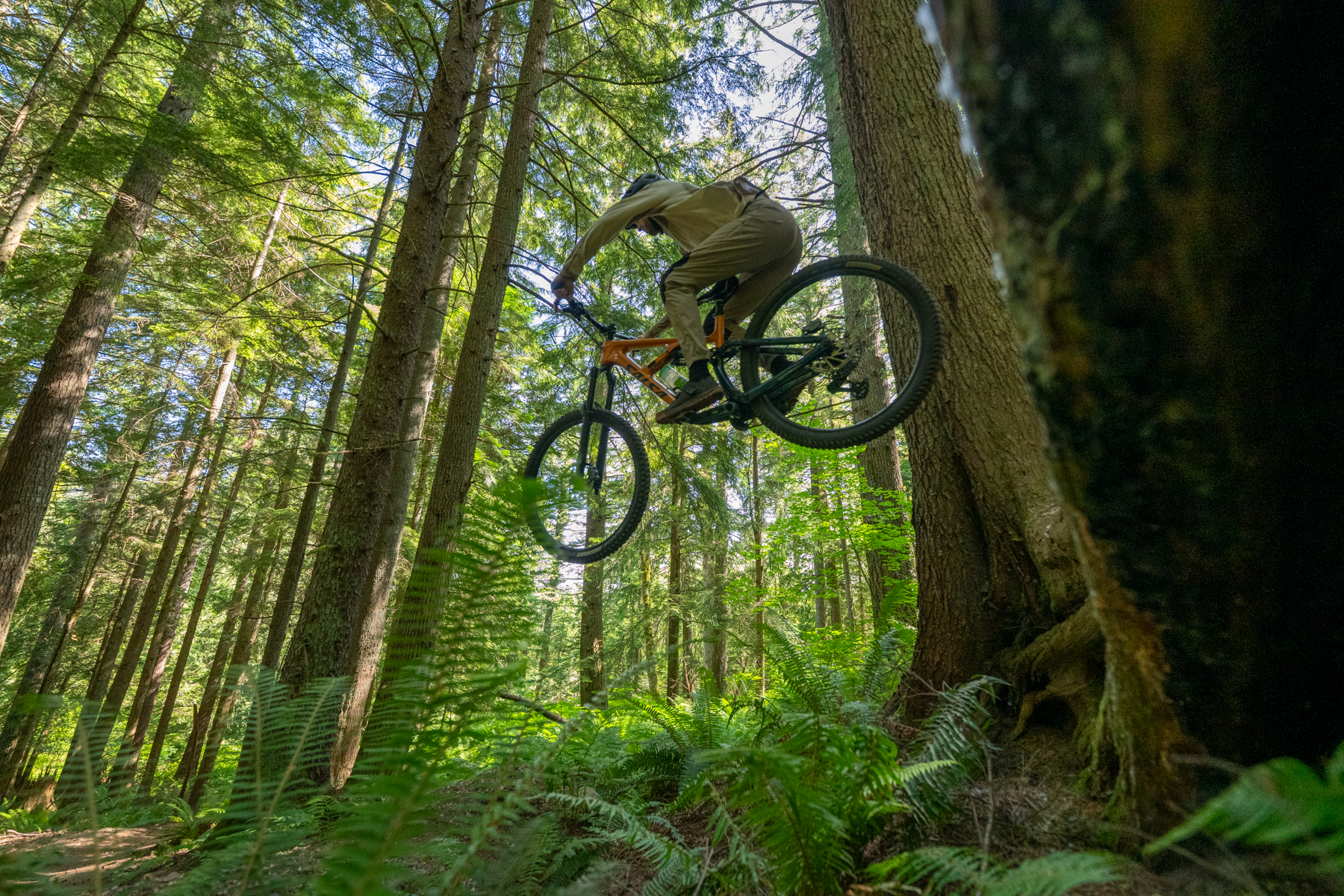
Descending
Simon: The Blackthorn’s descending performance isn’t as black and white as its climbing performance is; it’s still good overall, but there’s a bit more to unpack.
I initially thought the Blackthorn 145 had a somewhat playful personality, but the more time I spent trying to ride it with a playful approach, the more I realized it would push back a little and preferred a less active riding style. I also didn’t completely agree with David’s take from his Flash Review that it requires a more forward weight bias than is typical in this category.
However, after lots of miles, my perspective has changed a wee bit. I tend to agree more with David now, except that I think the Blackthorn naturally puts the rider in a more forward position. I don’t think it needs to be exaggerated much. That said, I also installed a grippier Maxxis Assagai front tire (3C MaxxGrip, DD casing) to complement the DHR II I installed for the mullet setup, and not surprisingly, that made a significant improvement in front-end grip — more on tires in the Build section.
David: I’ll just clarify my take here a bit: I stand by what I wrote in the Flash Review about the Blackthorn 145 favoring a relatively forward stance to maintain front-end grip, but mostly agree with Simon that the Blackthorn 145 encourages that sort of body positioning naturally, and I didn’t feel like I was fighting the bike on that front much.
Simon: The Blackthorn 145’s suspension feels decently supple at the beginning of the stroke and gives way to a quite firm mid-stroke and considerable bottom-out resistance. I found it hard to push into the suspension when descending to get the necessary weight transfer for a smooth manual. I think it likely has to do with the slightly forward body position as well, which gave me some trouble consistently finding the sweet spot. I’m either coming up too fast and having to use some rear brake to prevent looping out, or not coming up enough and casing whatever it is I’m trying to loft over.
In tight and twisty terrain, the Blackthorn 145 feels agile and responds well to steering input from your feet to induce some oversteer. I typically prefer mixed-wheel size bikes when cornering, and while the Blackthorn comes pretty close, I’ll still take a bike like the Santa Cruz Bronson when it comes to having a riot in the corners.
To be clear, the Blackthorn is not a poor descender, but I think the firm suspension holds it back a hair. With that said, I routinely used all the suspension travel and was able to hold good speed in chunky technical terrain, but I’m curious how it would do with a coil rear shock, or perhaps an air shock with a lighter compression tune. Overall, I think the aggressive geometry and firm suspension are in a bit of a tug-of-war, and when looking solely at the geometry numbers (mainly the slack head tube angle and short chainstays), they might lead you to believe it’s more shreddy than it is.
David: I think Simon and I are mostly on the same page about what the Blackthorn 145 does (and doesn’t) do best on the way down, but I might frame some of it a little differently, given our different preferences and local terrain.
The Blackthorn 145’s suspension is on the more supportive and lively / less plush and planted end of the spectrum, and I think that contributes to its preference for a forward stance on faster, rougher bits of trail in particular. Getting too far off the back starts to compromise front-end grip and ask a lot of the rear suspension in tandem, but if you stay forward on the Blackthorn 145 and focus on getting light over bigger compressions vs. asking the bike to plow through them, the Blackthorn 145 feels very sharp and lively, while still having enough cush to offer more margin for error than shorter-travel bikes tend to.
The tradeoff is that the Blackthorn 145 doesn’t have a huge sweet spot in terms of body positioning on the way back down, especially on steeper, rougher trails. If your local trails aren’t super steep and rough, but you want a little more suspension travel than a lot of the more efficient do-it-all Trail / All-Mountain bikes out there, the more sense that combo makes — and, again, the Blackthorn 145 pedals extremely well for a 145mm-travel bike. And the Blackthorn 145 can handle burly descents, too — it’s just a bit less composed and requires a bit more precision than a lot of the more planted, stable bikes in its travel bracket.
Blackthorn 145 as a Mullet
Simon: It was immediately apparent as soon as I swung a leg over the Blackthorn 145 after setting it up as a mullet that the geometry was clearly affected by the change, even with the flip chip in the “High” position. But, I expected that given Salsa recommends running shorter 165 mm cranks and a 2.5” rear tire, which indicates to me that the flip chip doesn’t go far enough in compensating for the smaller rear wheel. Honestly, I’m not a fan of claiming mixed wheel size compatibility with the caveat that you should go out and buy a new crankset (I’ll let the tire recommendation slide since you’ll be buying a new 27.5” tire and wheel anyway).
All that is to say that, having grown a mullet, the Blackthorn 145 feels a good bit lower and slacker. I had a crank strike within the first few feet of trail, so I instantly began the game of constantly clocking the cranks to avoid bashing rocks. Besides the crank strikes, I really like how the Blackthorn 145 rides as a mullet since it picks up some common mixed-wheelsize traits like the tendency to square off corners, and an overall more playful and rowdy personality (something I found a bit lacking in the non-mullet configuration).
Descending steep trails, the slacker head angle is noticeable and appreciated, as is the increased clearance between my butt and the rear tire — I’ve buzzed my butt many times with the 29” rear wheel and haven’t done it at all with the 27.5”. On the flip side, the slacker seat tube and head tube angles make the Blackthorn 145 mullet trickier to manage when climbing steep terrain, requiring a pretty dramatic forward shift onto the nose of the saddle to keep the front wheel tracking. The Blackthorn 145 mullet reacts well to riding more aggressively and is more fun to descend on. I think it swaps its talents and becomes a slightly better descender than climber, whereas in the 29er configuration, it’s the opposite.
Overall, I think there are better options for mullets, such as the Santa Cruz Bronson. Dedicated mixed-wheel size bikes don’t have to make sacrifices like an excessively low bottom bracket that requires shorter cranks. Would I buy new cranks and run it as a mullet if I owned it? Maybe, because ultimately I think running it as mullet shifts its performance in a way that, for me, is more in line with what I’m looking for in an All-Mountain bike.
I didn’t have 165 mm length cranks to try, so I can’t say if they will reduce the crank strikes to an acceptable level. I would need to get past being annoyed about having to buy cranks, too, and I think Salsa should either give the consumer the option of 165 mm cranks, or just spec them to begin with. All things considered, if the 165 mm cranks work well, I could see myself switching back and forth between a Blackthorn 145 with 29” wheels and fast rolling tires (like the spec’d Terrevails) set up to devour high alpine miles, and one with mixed-wheels and burly tires for more aggressive riding in gnarly terrain.
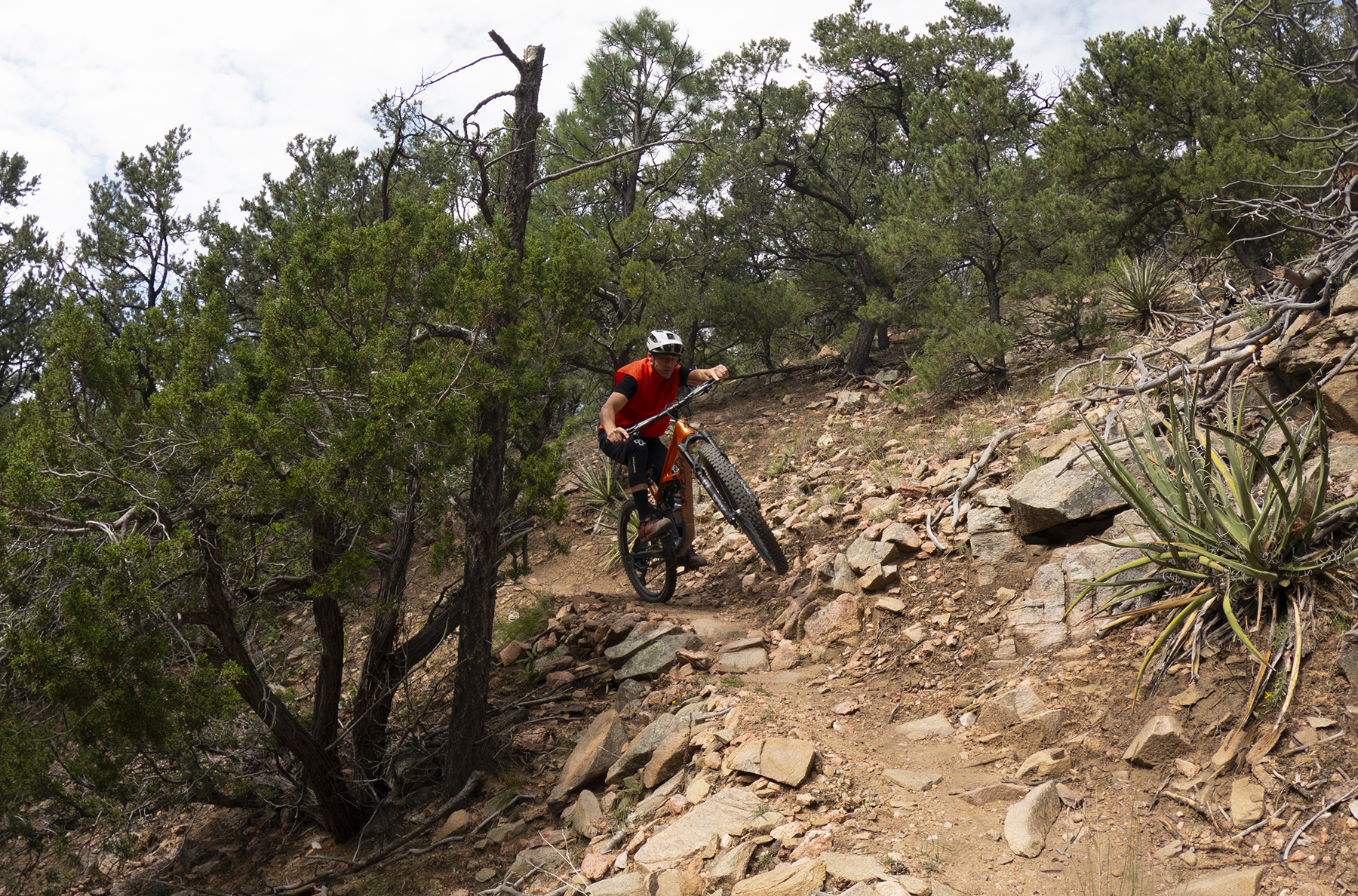
The Build
Simon: I’ll start with what I think is the most polarizing part of the Blackthorn’s spec, which is the tires. But before doing so, I’ll preface by saying, tire spec is often the subject of much scorn, and it’s impossible for bike companies to make everyone happy. Luckily, tires are not permanent; they wear out, presenting the perfect opportunity to try something that aligns more closely with personal preferences and riding conditions.
In the case of the Blackthorn 145, Salsa chose faster rolling, less-aggressive tires (Teravail Clifty front and rear) than we typically see on bikes with similar travel and aggressive geometry. I’m guilty of assuming they wouldn’t be up to snuff, and to be clear, when I received the Blackthorn 145 from David, he had already swapped out the front Teravail Clifty for a Terevail Kessel for exactly that reason. I was pleasantly surprised by the Teravail Kessel / Clifty combination and think it suits the Blackthorn’s efficient pedaling quite well.
When I set it up as a mullet, I went with beefier tires front and rear. I decided to go to the other side of the spectrum from the stock tires with a Maxxis Assagai MaxxGrip in the front and a Maxxis DHR II 3C MaxxTerra in the rear, both with the DoubleDown casing. Not surprisingly, the Maxxis combo improved traction considerably, but the extra rolling resistance is definitely noticeable. I also found the Maxxis tires gave the Blackthorn 145 a more supple ride feel. I’m currently recovering from a surgery to remove some bitchy screws from a broken femur injury almost a decade ago, so I’ve been appreciating the fast rolling Terrevail tires while my fitness comes back. My take is the fitter you are, the less you care about rolling resistance, so once it’s back, I would likely swap out the Terrevail tires for something more aggressive.
Staying on-brand, Salsa has built plenty of gear-carrying capability into the Blackthorn 145’s frame, but strangely, it doesn’t have in-frame storage, which seems like it would be a good fit for Salsa’s adventure-by-bike ethos. That said, we know frame storage usually adds weight to the frame, and Salsa’s built-in frame strap system is probably a lighter solution.
Other build highlights include the SRAM GX Transmission drivetrain and SRAM Maven brakes, which were both flawless in their performance.
The Blackthorn 145 has good frame protection on the downtube and chainstay, plus it comes with a chainguide; however, I noticed considerable chain slap when descending anything even remotely chunky. It’s pretty noisy downhill.

Who’s It For?
Simon: The Blackthorn 145 is a great option for those seeking an efficient All-Mountain bike that climbs a lot like an XC / Trail bike, and has a more upright and comfortable seated riding position — a winning combination for riders who spend the majority of their time on long climbs.
I think the ideal candidates are riders who typically prefer shorter travel XC / Trail bikes but would like more travel and all-around capability without sacrificing much climbing performance. When descending, the Blackthorn 145 isn’t a bike that demands to be ridden with a lot of aggression, and has a more easy-going personality than a lot of similar bikes in its travel category.

Bottom Line
Simon: The Salsa Blackthorn 145 is a good all-around Trail bike that leans heavily towards the efficient and responsive side of the spectrum, which makes it a slightly better climber than descender. Its talents are best appreciated on long days in the saddle, and it has proven to be an excellent companion when climbing up above treeline. It turns out I mostly agree with Salsa’s claim that the Blackthorn 145 is the best All-Mountain bike for chasing adventure by bike in the mountains”, whether it’s the “best” is debatable, but it is undoubtedly very good.
Deep Dive Comparisons
BLISTER+ members and those who purchase our Digital Access Pass can check out our Deep Dive comparisons linked below. Get our Digital Access Pass to view all our Deep Dives and Flash Reviews, or become a BLISTER+ member today to get access to that and a LOT more, including the best worldwide Outdoor Injury Insurance, exclusive deals and discounts on skis, personalized gear recommendations from us, and much more.

Deep Dive: Salsa Blackthorn 145 C
We compare the Salsa Blackthorn to the Rocky Mountain Instinct, Transition Sentinel V3, Santa Cruz Bronson 5, Santa Cruz Hightower 4, Spot Mayhem 140, Esker Woodsy, Propain Tyee, Norco Sight, Transition Sentinel V3, and Kona Process 153.
Blister’s Flash Reviews and Deep Dives are accessible to those who purchase one of our paid subscriptions
To get our comprehensive Deep Dives and our initial, unfiltered reports on new gear, become a member and receive many other services, deals, and discounts.
If you’re already an active member, please log in.
(If you’re already logged in and a member in good standing and seeing this message in error, please refresh this page in your browser.)

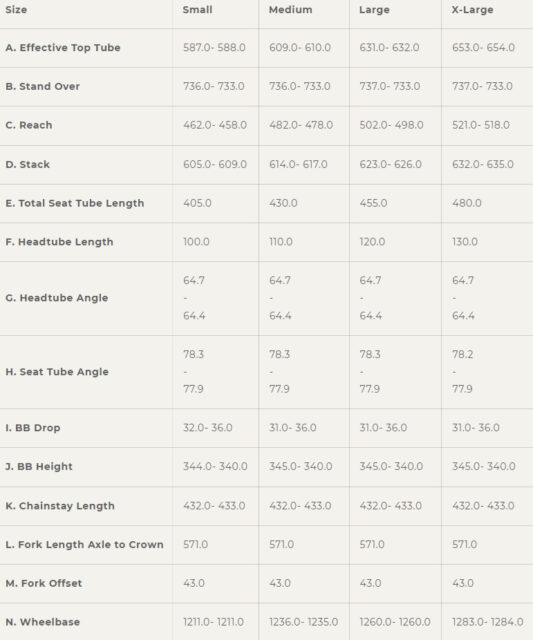
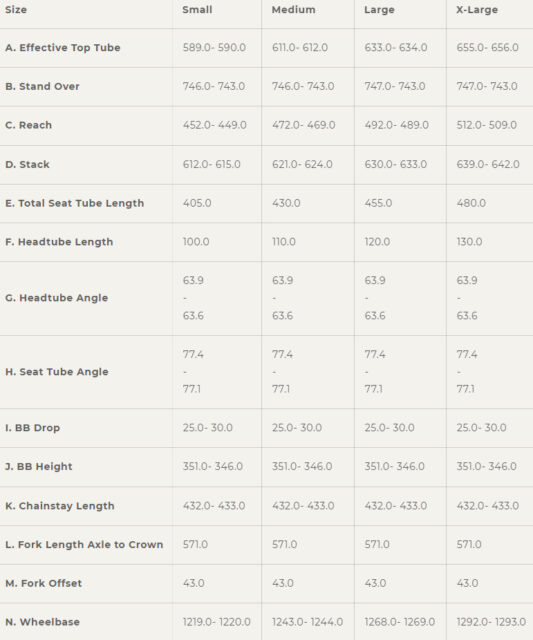
Look like fun, straightforward bikes.
Comment:
Thanks for the detailed and well-done test report! I’ve been riding the bike myself since spring and I’m really happy with it overall. I’ve tested it extensively in a variety of terrain and made some internal adjustments to the suspension. One small addition regarding the coil shock: I equipped the bike with an EXT suspension setup right from the start. After a few fine-tunings on the shock and fork, the setup now feels almost perfect for me. I can’t say how it rides with an air shock, but with the coil it feels like a mini enduro bike – only in really rough terrain does it reach its limits.
For me, it’s a Trailbike Plus – agile, playful, efficient to pedal, and very capable on the descents. It’s ideal for high-alpine enduro tours where there’s a lot of climbing involved. Since then, my full-on enduro bike has been sitting in the garage almost unused.